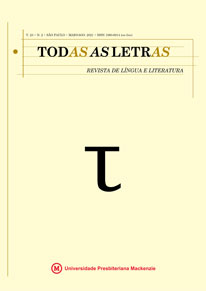Polysemy in the construction grammar
An analysis from transitive construction
Keywords:
Usage-Based Linguistics. Construction Grammar. Transitive construction. Inheritance relations. Polysemy.Abstract
Based on the theoretical framework of Usage-Based Linguistics and in the Construction Grammar, this paper analyzes a type of inheritance relationship, the polysemy links, in tokens of the transitive construction. The examination of empirical data argues that speakers extend the basic meaning of this construction, which is linked to a prototypical transitive scene, to cover other types of events that depart from the prototype. Thus, the shape is paired with different meanings, showing constructional polysemy.
Downloads
References
BYBEE, J. Language, usage and cognition. Cambridge: United Kingdon University Press, 2010.
CEZARIO, M. M.; FURTADO DA CUNHA, M. A. (Orgs.). Linguística centrada no uso: uma homenagem a Mário Martelotta. Rio de Janeiro: Mauad X/FAPERJ, 2013.
CROFT, W. Radical Construction Grammar: syntactic theory in typological perspective. Oxford: Oxford University Press, 2001.
CROFT, W; CRUSE, A. Cognitive lingüistics. Cambridge: Cambridge University Press, 2004.
DU BOIS, J. W.; KUMPF, L. E.; ASHBY, W.J. (Eds.). Preferred Argument Structure: Grammar as architecture for function. Amsterdam: Benjamins, 2003.
FERRARI, L. Introdução à Linguística Cognitiva. São Paulo: Contexto, 2011.
FILLMORE, C. On grammatical construction. California: UCB, 1988.
FILLMORE, C.; KAY, P.; O'CONNOR, C. Regularity and Idiomaticity in Grammatical Constructions: The Case of Let Alone. Language, n. 64, p. 501-538, 1988.
FRIED, M. Construction Grammar. In: ALEXIADOU, A.; KISS, T. (Eds.) Handbook of Linguistics and Communication Science. Berlin: Mouton de Gruyter, 2015, p. 974-1003.
FURTADO DA CUNHA, M. A. (Org.). Corpus Discurso & Gramática – a língua falada e escrita na cidade do Natal. Natal: EDUFRN, 1998.
______. Banco Conversacional de Natal. Natal: EDUFRN, 2011.
FURTADO DA CUNHA, M. A.; SILVA, J. R. Transitividade: do verbo à construção. Revista Linguística. V. 14, n. 1, p. 48-64, 2018.
GOLDBERG, A. E. A construction grammar approach to argument structure. Chicago: University of Chicago Press, 1995.
______. Constructions at work: the Nature of Generalization in Language. New York: Oxford University Press, 2006.
LAKOFF, G. Women, fire and dangerous things: what categories reveal about mind. Chicago: University Chicago Press, 1987.
LANGACKER, R. Cognitive Grammar: a basic introduction. Oxford: Oxford University Press, 2008.
LOPES, M. G. A construção transitiva prototípica e a construção transitiva causativa no português: um caso de variação construcional? Diadorim, Rio de Janeiro, v. 21, n. 2, p. 99-124, 2019.
LUCENA, N. L. A Construção Transitiva no português brasileiro: aspectos cognitivo-interacionais. Revista Linguística, v. 14, n. 1, p. 65-82, 2018.
MARTELOTTA, M. Mudança linguística: uma abordagem baseada no uso. São Paulo: Cortez, 2011.
MINAYO, M. C. S. (Org.). Pesquisa Social: teoria, método e criatividade. 18 ed. Petrópolis: Vozes, 2001.
OLIVEIRA, R. P. Semântica. In: MUSSALIM, F.; BENTES, A. C. (orgs.). Introdução à lingüística: domínios e fronteiras, v.2. 1. ed. São Paulo: Cortez, 2001, p. 23-54.
SALOMÃO, M. M.; MIRANDA, N. (Orgs.). Construções do português do Brasil: da gramática ao discurso. Belo Horizonte: EDUFMG, 2009.
SLOBIN, D. The origins of grammatical encoding of events. In: HOPPER, P. (Ed.). Syntax and semantics, v. 15, Studies in transitivity. New York: Academic Press, p. 409-422, 1982.
SILVA, A. S. O mundo dos sentidos em português: polissemia, semântica e cognição. Coimbra: Almedina, 2006.
TALMY, L. Force dynamics in language and cognition. Cognitive Science, v. 12, p. 49-100, 1988.
TAYLOR, J. Linguistic categorization. New York: Oxford University Press, 2003.
TOMASELLO, M. (Ed). The new psychology of language cognitive and functional approaches to language structures. New Jersey: Lawrence Erlbaum, v. 1, 1998.
______. (Ed). The new psychology of language cognitive and functional approaches to language structures. New Jersey: Lawrence Erlbaum, v. 2, 2003.
TRAUGOTT, E; TROUSDALE, G. Constructionalization and constructional changes. New York: Oxford University Press, 2013.
Downloads
Published
How to Cite
Issue
Section
License
The originals accepted and published become property of Mackenzie Presbyterian University, being forbidden their total or partial reproduction without permission of the Editorial Board, except for study and research.




